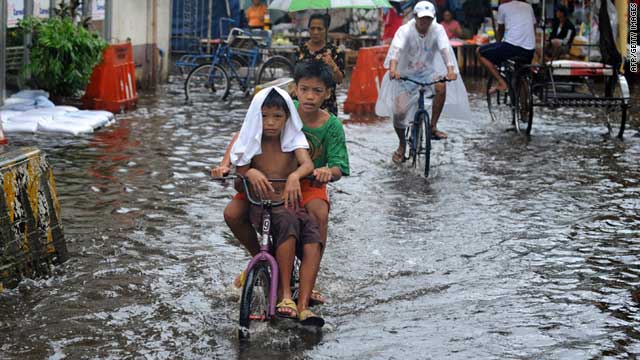The storm has been menacing the Philippines since Tuesday, when 11 fishermen went missing along the coast of Luzon, according to the National Disaster Risk Reduction and Management Council.
The storm was forecasted to move Saturday toward Basco, Batanes, the smallest of the Philippine provinces, the council said. By Sunday, the storm was expected to be 370 kilometers (229.9 miles) west northwest of Okinawa, Japan, the agency said.

Children pedal their bicycle down a flooded street after heavy rains in Valenzuela City, north of Manila on June 23, 2011
Flash floods were reported in a number of Philippine communities, including Ligao City where one woman was reportedly washed away by floodwaters, the council said in a statement posted on its website.
A landslide struck in a rural area of Olongapo City, forcing the evacuation of three families, the council said.
Thirty international flights as well as 26 domestic flights were canceled because of the storm, the Civil Aviation Authority said.
About 32,000 families in 17 cities were displaced by the storm, the emergency management agency said. Another 10,143 families have been evacuated from their homes in advance of anticipated flooding, the agency said.
71 dead in Philippines after weeks of flooding
January 25, 2011 -- Updated 1906 GMT (0306 HKT)
71 dead in Philippines after weeks of flooding -- A month of sustained rains have now killed at least 71 people in the Philippines, disaster authorities said Tuesday.
Another 23 people are missing and 13 people have been injured, according to the National Disaster Risk Reduction and Management Council. More flooding is expected in the days ahead.
The crisis began weeks ago, on December 29, when a monsoon over northern and central Luzon met a cold front in southern Luzon, Visayas and Mindanao. The result was severe flooding and landslides in 25 provinces.
The storms have affected nearly 1.6 million people from more than 300,000 families, according to the disaster agency. Damage to crops and infrastructure is estimated at $40 million.
December and January are traditionally part of the Philippines' dry season, with heavy rain more common in the islands from May to October, during the summer monsoon. ( cnn )
No comments :
Post a Comment